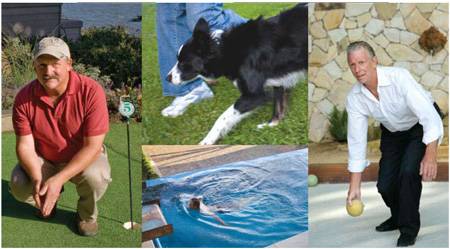Home Putting Greens
If Pete Pedersen of Pedersen Associates squints just so, he imagines that he’s “putting out to the 18th hole of Pebble Beach,” instead of standing on his client’s San Rafael putting green. That’s what makes Al Lamperti’s bayside garden such a standout. Even if it didn’t evoke images of the fabled California golf course, the putting green, hugged by Monterey cypresses and overlooking a gravelly beach, would still be postcard-perfect. The best putting greens are all about the setting, says Pedersen. “Certainly, the great courses are as much about their setting as their challenges and
Al has a world-class setting.”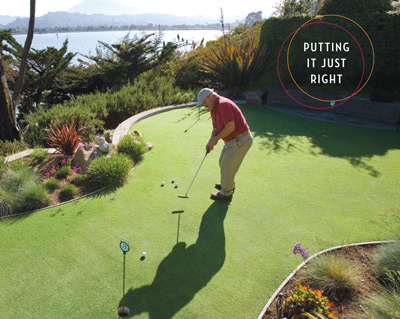
This 650-square-foot green, with five holes and a grassy fringe border, is protected from the wind by a seven-foot-high wall and enhanced with low plantings and perennials that produce minimal flower debris. Pedersen consulted with an installer to give the green a slightly undulating subsurface for more variety. “It’s important to know where the holes should be placed and where the subtle breaks and the short and long putts should be,” Pedersen says. “That way you can put a lot of challenge in a small area.”
Lamperti, a single-digit handicapper, is never bored with it, says Pedersen. He may play seriously at the country club, but he likes having a mini-green just outside his door.
“It was a nice way to do a landscape that didn’t require a lot of maintenance,” Lamperti says, “and it’s great to have friends come over for a glass of beer and a putting contest.”
Backyard Dog Agility Courses
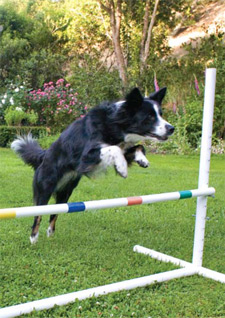 When Ronette King isn’t designing high-end projects as a principal of the global architecture firm Gensler, she’s active in competitive agility, a sport that involves a dog and his handler moving quickly through an obstacle course.
When Ronette King isn’t designing high-end projects as a principal of the global architecture firm Gensler, she’s active in competitive agility, a sport that involves a dog and his handler moving quickly through an obstacle course.
For more than a decade, King has practiced (first with shelties and now with a rescued border collie named Sprite) on a backyard agility course that includes jumps, a hanging tire, a tunnel, a pause table and weave poles. To change it up, she regularly reconfigures the course and often invites friends and their dogs to practice with her.
“It’s a great sport; it’s fast and the dog has to be very attuned to you to run a course accurately within a tight time frame,” she says. “He has to watch the subtle nuances in your body to take an obstacle course that he doesn’t know, and you’ve only walked it once 10 minutes earlier. The hardest thing is trying to remember the sequence of obstacles as your dog is flying through the air.”
The obstacles are lightweight, portable and inexpensive. She figures her course cost a few hundred dollars; a dog walk, A-frame or teeter are more expensive obstacles.
While small, agile herding dogs are the most typical canine participants, “any breed can do it as long as they have the drive and desire and are physically capable,” says Kristin Herrera, a trainer at the Marin Humane Society. It may be difficult for the largest breeds, though.
Dogs should be in good physical condition without joint problems and those under two years old should practice on very low jumps until their growth plates close. Training should be positive. “It’s the best way if you want a spirited, happy dog,” King says. “It’s not about bullying. You can’t expect an animal to be happy and confident if you keep correcting him.”
The perks of agility go beyond exercise and obedience, Herrera notes. “It strengthens the relationship between dog and owner, and each family member who learns how to handle the dog through the obstacles can have fun—or they can cheer the team on from the sidelines.”
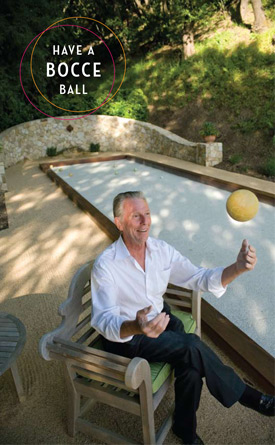 Backyard Bocce
Backyard Bocce
After playing bocce ball at the home of Napa friends, a Ross resident hired David Brewer, of Brewer Landscape Construction and Boccebrew, to design a bocce court for her family, too. “We had so much fun,” she says. “It’s really an icebreaker and a great family game.”
The family “aren’t serious players,” Brewer says, “but they had fallen in love with the idea of playing bocce ball and wanted a court for entertaining. They were most intrigued with the idea of having friends over, having some good food, a great time and some laughs.”
The 10-by-60-foot court, composed of a traditional oyster shell surface, is tucked alongside a path close to the house and overlooks the main garden of mature trees and flowering plants.
Bocce, an ancient sport, “is the original form of pitching pennies,” Brewer quips. “It’s that idea of ‘I can get my rock closer to this rock and I bet you that you can’t.’”
The game is the ultimate equalizer, he adds. “Anybody can learn to play in a few minutes. It requires practice and diligence to develop the touch and technique to do it well, but somebody in a wheelchair can play this game well enough to beat someone who can run a marathon.”
Tony Bertotti, of Bertotti Landscaping, prefers the traditional oyster shell surface to the less expensive decomposed granite. “It’s the best material,” he says. “It gives a soft, firm surface for the roll of the ball. And, unlike with decomposed granite, little pieces of rock won’t surface and interfere with the ball.” He also likes wood siding for “a true bounce,” but understands the aesthetic appeal of stone.
Ideally, the court should have excellent drainage and be located away from vegetation that drops leaves or needles, but there should be shade and seating nearby for comfort. Maintenance is minimal: a soft-bristle broom for smoothing out divots, followed by a good soaking. An occasional re-rolling and new top-dusting of oyster flour is suggested.
Endless Pools
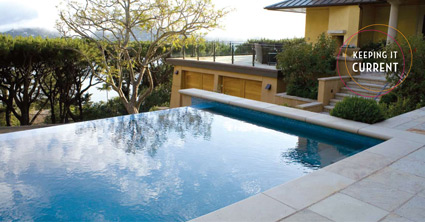 So long diving board; hello swim jets. Sport pools with swim jets are one of the pool industry’s hottest innovations, taking swimming or any pool activity to another level.
So long diving board; hello swim jets. Sport pools with swim jets are one of the pool industry’s hottest innovations, taking swimming or any pool activity to another level.
A Belvedere resident who wanted such a pool hired San Anselmo landscape architect Jim Catlin, of Catlin Landscape Architecture, to come up with a landscape design. The goal was to not only complement the home’s Mediterranean architecture and its beautiful San Francisco Bay backdrop, but also accommodate a pool that would provide a powerful, low-impact workout.
Catlin worked with Todd Hendrickson of Aquascape Custom Crafted Pools on the pool’s design and installation and planted the slope above it with olive trees, lavender and roses. The pool has jets by Badu.
“It’s one of my favorite pools,” Catlin says. “When you’re on the patio and look out on the vanishing edge pool, it almost looks like the pool is pouring into the bay. It seems so seamless.” That’s the result of just the right choice of sky-blue glass tile and gray plaster, he notes.
Unlike traditional pools with a shallow and a deep end, sport pools are generally shallow on both ends with a deeper center of about five feet. They fit in spaces too small for conventional pools and, because they’re shallow, are less expensive to heat.
“There’s no diving, but you can stand at either end of the pool and play water polo, volleyball or basketball,” Hendrickson says. Children like to “ride” the currents created by the adjustable jets; some adults like to “aqua jog”; and swimmers like the workout provided by the resistance of the jets and being able to swim continuously without doing one kick-turn. (Still, some do prefer the gentler motion of the motor-propelled Endless Pool system to the more vigorous model.)
Hendrickson uses his own 19-foot-long jetted sport pool to train before going on surfing trips with friends. “I paddle every evening for about 20 minutes about two months before the trip. Everyone else (surfing) will get tired, but I can stay on the water four or five hours or longer.”
CAPTIONS: (top, right): Pete Pedersen practices his putting on green he installed in Belvedere. (middle, Left): Sprite doing what she does best. (middle, right): David Brewer of Brewer Landscape Construction and Boccebrew. (bottom, left): Jim Catlin of Catlin Landscape Architecture and Todd Hendrickson of Aquascape Custom Crafted Pools worked together to create a swimming pool that provides a powerful, low-impact workout for a Belvedere resident.

